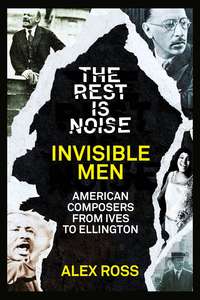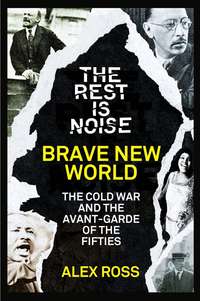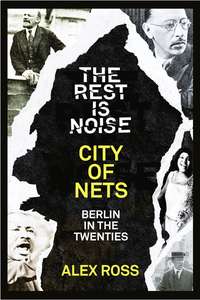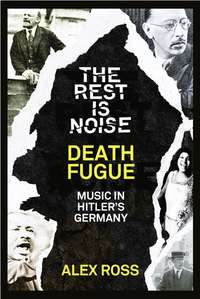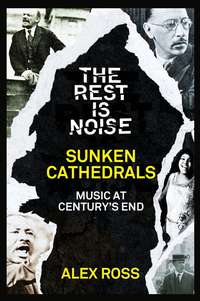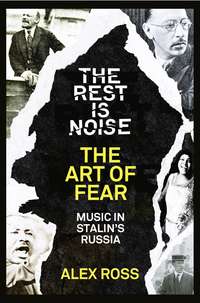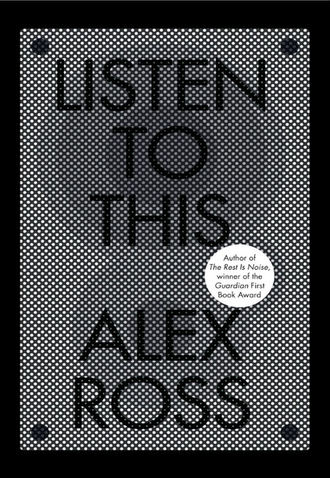
Полная версия
Listen to This
Sooner or later, every critique of recording gets around to quoting Walter Benjamin’s essay “The Work of Art in the Age of Its Technological Reproducibility,” written in the late 1930s. The most often cited passage is Benjamin’s discussion of the loss of an “aura” surrounding works of art—the “here and now” of the sacred artistic object, its connection to a well-defined community. This formulation seems to recall the familiar lament, going back to Sousa, that recordings have leeched the life out of music. But when Benjamin spoke of the withering of aura and the rise of reproducible art, lamentation was not his aim. While he stopped short of populism, he voiced a nagging mistrust of the elitist spiel—the automatic privileging of high-art devotion over mass-market consumption. The cult of art for art’s sake, Benjamin noted, was deteriorating into fascist kitsch. The films of Charlie Chaplin, by contrast, mixed comic pratfalls with subversive political messages. In other words, mechanical reproduction is not an inherently cheapening process; an outsider artist may use it to bypass cultural gatekeepers and advance radical ideas. That the thugs of commerce seldom fail to win out in the end does not lessen the glory of the moment.
Although classical performers and listeners like to picture themselves in a high tower, remote from the electronic melee, they, too, are in thrall to the machines. Some of the most overheated propaganda on behalf of new technologies has come from the classical side, where the illusion of perfect reproduction is particularly alluring. Classical recordings are supposed to deny the fact that they are recordings. That process involves, paradoxically, considerable artifice. Overdubbing, patching, knob-twiddling, and, in recent years, pitch correction have all come into play. The phenomenon of the dummy star, who has a hard time duplicating in the concert hall what he or she purports to do on record, is not unheard of.
Perhaps there is something unnatural in the very act of making a studio recording, no matter how intelligent the presentation. At the height of the hi-fiera, leading classical producers and executives—Walter Legge, at EMI; Goddard Lieberson, at Columbia Records; and John Culshaw, at Decca, to name three of the best—spent many millions of dollars engaging top-of-the-line orchestras, soloists, and conductors in an effort to create definitive recordings of the peaks of the repertory. They met their goal: any short list of gramophone classics would include Maria Callas’s Tosca, Wilhelm Furtwängler’s Tristan und Isolde, Georg Solti’s Ring, and Glenn Gould’s Goldberg Variations, all recorded or set in motion in the fifties. Yet the excellence of these discs posed a problem for the working musicians who had to play in their wake. Concert presenters began to complain that record collectors had formed a separate audience, one that seldom ventured into the concert hall. Recordings threatened to become a phantasmagoria, a virtual reality encroaching on concert life. (Gould claimed that the Decca Ring achieved “a more effective unity between intensity of action and displacement of sound than could be afforded by the best of all seasons at Bayreuth.”) When people did venture out, they brought with them the habits of home listening. The solitary ritual of absorbing symphonies in one’s living room almost certainly contributed to the growing quietude of the classical public; that applause-free spell after the first movement of the Eroica matches the whispery groove on the long-playing record.
Like Heisenberg’s mythical observer, the phonograph was never a mere recorder of events: it changed not only how people listened but also how they sang and played. Mark Katz, in his book Capturing Sound, calls these changes “phonograph effects.” (The phrase comes from the digital studio, where it is used to describe the crackling, scratching noises that are sometimes added to pop-music tracks to lend them an appealingly antique air.) Katz devotes one chapter of his book to a shift in violin technique that occurred in the early twentieth century. It involved vibrato—the trembling action of the hand on the fingerboard, whereby the player is able to give notes a warbling sweetness. Early recordings and written evidence suggest that in prior eras vibrato was used more sparingly than it is today. By the twenties and thirties, many leading violinists had adopted continuous vibrato, which became the approved style in conservatories. Katz proposes that technology prompted the change. When a wobble was added to violin tone, the phonograph was able to pick it up more easily; it’s a “wider” sound in acoustical terms, a blob of several superimposed frequencies. Also, the fuzzy focus of vibrato enabled players to cover up inaccuracies of intonation, and, from the start, the phonograph made players more self-conscious about intonation than they were before. What worked in the studio then spread to the concert stage.
Robert Philip, a British scholar who specializes in performance practice, tackles the same problem in his book Performing Music in the Age of Recording. He proposes that when musicians listened to records of their own playing they passed through a kind of mirror stage; for the first time, they were forced to confront their “true” selves. “Musicians who first heard their own recordings in the early years of the twentieth century were often taken aback by what they heard, suddenly being made aware of inaccuracies and mannerisms they had not suspected,” Philip writes. When they went back onstage, he says, they tried to embody the superior self that they glimpsed in the phonographic mirror, and never again played in quite the same way.
Philip gives a riveting description of what classical performances sounded like at the turn of the last century. “Freedom from disaster was the standard for a good concert,” he writes. Rehearsals were brief, mishaps routine. Precision was not a universal value. Pianists rolled chords instead of playing them at one stroke. String players slid expressively from one note to the next—portamento, the style was called—in imitation of the slide of the voice. In a 1912 recording, the great Belgian violinist Eugène Ysaÿe “sways either side of the beat, while the piano maintains an even rhythm.” Orchestras flirted with chaos in an effort to generate maximum passion—witness Edward Elgar’s recordings of his music. And the instruments themselves sounded different, depending on the nationality of the player. French bassoons had a pungent tone, quite unlike the rounded timbre of German bassoons. French flutists, by contrast, used more vibrato than their German and English counterparts, supplying a warmer, mellower quality. American orchestral culture, which brought together immigrant musicians from all European countries, began to erode the differences, and recordings helped to cement the new standard practice. Whatever style sounded cleanest on the medium—in these cases, German bassoons and French flutes—became the golden mean. Young virtuosos today may have recognizable idiosyncrasies, but their playing seldom indicates that they have come from any particular place or that they have emerged from any particular tradition.
Opera is prey to the same standardizing trend. The conductor and scholar Will Crutchfield cites a startling example of a “phonograph effect” in an essay on changing perceptions of operatic style. He once sat down to compare all extant recordings of “Una furtiva lagrima,” the plaintive tenor aria from Donizetti’s bel-canto comedy L’elisir d’amore. Crutchfield wanted to know what singers of various eras have done with the cadenza—the passage at the end of the aria where the orchestra halts and the tenor engages in a few graceful acrobatics. Early recordings show singers trying out a range of possibilities, some contemplative, some florid, none the same. Then came Caruso. He first recorded “Una furtiva lagrima” in 1902, and returned to it three more times in the course of his epochal studio career. After that, tenors began imitating the stylish little display that Caruso devised: a quick up-and-down run followed by two slow, tender phrases. Out of more than two hundred singers who have recorded the aria since Caruso’s death, how many try something different? Crutchfield counts four. Many operagoers would identify Caruso’s cadenza as the “traditional” one, but Crutchfield calls it the “death-of-tradition” cadenza, the one that stifled a long-flourishing vocal practice.
The tics and traits of old-school performance—moving ahead or behind the beat, sliding between notes, breaking chords into arpeggios, improvising cadenzas, adding ornaments as the style demands—are alike in bringing out the distinct voices of the performers, not to mention the mere fact that they are fallible humans. Most modern playing tends to erase all evidence of the work that has gone on behind the scenes: virtuosity is defined as effortlessness. One often-quoted ideal is to “disappear behind the music.” But when precision is divorced from emotion it can become anti-musical, inhuman, repulsive. Is there any escape from the cycle? Robert Philip, having blamed recordings for a multitude of sins, ends by saying that they may be able to come to the rescue. By studying artifacts from the dawn of the century, musicians might recapture what has gone missing from the perfectionist style. They can rebel against the letter of the score in pursuit of its spirit. There are, however, substantial psychic barriers in the way of such a shift: performers will have to be unafraid of trying out mannerisms that will sound sloppy to some ears, of committing what will sound like mistakes. They will have to defy the hyper-competitive conservatory culture in which they came of age, and also the hyper-professionalized culture of the ensembles in which they find work.
In at least one area, performance style has undergone a sea change. Early music long had the reputation of being the most pedantically “correct” subculture in classical music, but in recent years the more dynamic Renaissance and Baroque ensembles—Jordi Savall’s Hespèrion XXI, William Christie’s Les Arts Florissants, Rinaldo Alessandrini’s Concerto Italiano, and various groups led by the violinist Andrew Manze and the keyboard player Richard Egarr, to name a few—have begun exercising all the freedoms that have gone missing in much modern performance. They execute some notes cleanly and others roughly, they weave around the beat instead of staying on top of it, they slide from note to note when they are so moved. If the score calls for or expects a cadenza or improvisation, they execute one of their own invention. As a result, the music feels liberated, and audiences respond in kind, with yelps of joy. Christie has said that his group is modeled on Duke Ellington’s band of 1929: players amble in and out of the spotlight, adding daubs of color before rejoining the background. If, in coming years, the freewheeling spirit of the early-music scene enters into performances of the nineteenth-century repertory, classical music may finally kick away its cold marble façade.
For those of us who grew up during the extended heyday of recordings, the digital landscape of the early twenty-first century presents a confusing picture. The record labels, which long held sway with an iron or velvet fist, are reeling, their products downloaded everywhere on file-sharing networks, their attempts to police piracy verging on the fascistic. The concept of a discrete album of songs or works is probably in terminal decline. In pop, the main money is now to be made in the packaging of tours and the selling of merchandise. Prince gave away millions of copies of his 2007 album Planet Earth as a way of luring audiences to his shows. In the same year, Radiohead offered its latest album, In Rainbows, through its own website, instructing fans to pay whatever they wished. The technology of easy access has become so sophisticated that it is undermining the corporate structure which brought it into being—a development that might have delighted Walter Benjamin. The brainy moguls of decades past are to be mourned, but in the long run it may not be a bad thing that young people have stopped hoarding music in the form of packaged objects. Music is no longer a prize in a collection; it is returning to its natural evanescent state.
Classical music, or a portion thereof, is thriving online in unexpected ways. Perhaps no one should be surprised; if, as people say, the Internet is a paradise for geeks, it would logically work to the benefit of one of the most opulently geeky art forms in history. The more resourceful organizations are offering live and archived audio (you can hear almost every event in London’s summertime Proms series through the website of the BBC), setting up online listening guides (the San Francisco Symphony has hightech maps of the Eroica and The Rite of Spring), assembling fastidious archives (the Metropolitan Opera site can tell you in a matter of seconds when any singer made his or her debut), and peddling studio-master-quality audio downloads (the Tallis Scholars sell their impeccable recordings of Renaissance masses). Web-savvy young composers, meanwhile, no longer depend on publishers to reach their public, distributing their wares through blogs, MySpace, YouTube, Facebook, Twitter, and whatever social network becomes fashionable after this book goes to press.
The diffusion of classical music online is a boon for fans, and it may also ease the fears of the infamous “culturally aware non-attenders.” Novice concertgoers and operagoers can shop for tickets, read synopses of unfamiliar plots, listen to snippets of unfamiliar music, read performers’ blogs, and otherwise get their bearings out on the tundra of the classical experience. First-time record-buyers can read reviews, compare audio samples, and decide on, for example, a Beethoven recording by Furtwängler, all without risking the humiliation of mispronouncing the conductor’s name under the gaze of a grumpy record clerk. In the days before the collapse of the record business, when megastores like Tower Records were thriving, sepulchral soundproofed doors divided the classical department from the rest of humanity. For better or worse, classical music no longer inhabits a separate room; it is in the mix.
At the same time, classical music stands partly outside the technological realm, because most of its repertory is designed to resonate naturally within a room. By contrast, almost all pop music is written for microphones and speakers. In a totally mediated society, where some form of electronic sound saturates nearly every minute of our waking lives, the act of sitting down in a concert hall, joining the expectant silence in the moments before the music begins, and surrendering to the elemental properties of sound can have an almost spiritual dimension. Classical supremacists of prior years might have described it as a rite of elevation, but for me it is something more primal and enigmatic. Forms coalesce and then vanish, like Rimsky-Korsakov’s phantom city of Kitezh.
In 1926, twenty years after Sousa foretold doom, the critic Hans Heinz Stuckenschmidt reflected on the mechanization of music and came to this eminently sane conclusion: “The machine is neither a god nor a devil.” Mark Katz uses that quotation as an epigraph to Capturing Sound, and it nicely sums up the whole shebang. Neither the utopian nor the apocalyptic vision of the musical future has come to pass. People have plenty of pirated music in their cupboards, but they are still turning out for live performances, paying hundreds or even thousands of dollars to catch a glimpse of their idols. Music education is in tatters, but the impulse to make music with the voice, with an instrument, or on a computer remains. The critic David Hajdu, in an essay on the phenomenon of home remixing (creating new versions of songs on home computers), notes a curious throwback. “Members of the musical public are again assuming participatory roles, interpreting compositions at home, much as late Victorians played sheet music in parlor musicales,” he writes. In other words, we are almost back to where we started.
When I sift through my musical memory, I find that real and virtual events are inextricably jumbled. The strongest echoes are of live performances that shook me to the core: Mahler’s Eighth Symphony at Carnegie Hall, under the direction of the incomparable choral conductor Robert Shaw, with more than four hundred singers roaring forth in the first- and second-tier boxes; the post-punk bands Fugazi and the Ex in a sweat-drenched church basement in Washington, D.C., firing up a mass of youthful bodies; Gidon Kremer and five other musicians in an Austrian village church at midnight, presenting an extraordinarily eerie chamber arrangement of Shostakovich’s Fifteenth Symphony. Then again, certain recordings carry an acute emotional charge: I think of the Bernstein Eroica that I pretended to conduct as a child, the LPs of Mahler’s Sixth that I blasted in high school late at night, the Pere Ubu CD that forced me to abandon my cavalier dismissal of rock music. But I can’t replicate the psychic impact of those first encounters. They were unrepeatable events on a private stage. As the composer and theorist Benjamin Boretz has written, “In music, as in everything, the disappearing moment of experience is the firmest reality.”
Nothing in my listening life can compare to the experience of Hans Fantel, an author and critic who for many years covered audio matters for The New York Times. In 1989 he wrote about what it was like for him to listen to a CD reissue of a classic disc: a live recording, made on January 16, 1938, of the Vienna Philharmonic playing Mahler’s Ninth Symphony, under the direction of Bruno Walter. Fantel spent his childhood in Vienna, and he attended that performance with his father.
“We could not know on that winter Sunday that this would turn out to be the last performance of the Vienna Philharmonic before Hitler crushed his homeland to make it part of the German Reich,” Fantel wrote. “The music, captured that day by the bulky old microphones I remember strung across the stage, was the last to be heard from many of the musicians in the orchestra. They and their country vanished.” Fantel put on the record and relived the occasion. “I could now recognize and appreciate the singular aura of that performance: I could sense its uncanny intensity—a strange inner turmoil quite different from the many other recordings and performances of Mahler’s Ninth I had heard since.”
Some of the turmoil was Fantel’s own. “This disc held fast an event I had shared with my father: seventy-one minutes out of the sixteen years we had together. Soon after, as an ‘enemy of Reich and Führer,’ my father also disappeared into Hitler’s abyss. That’s what made me realize something about the nature of phonographs: they admit no ending. They imply perpetuity … Something of life itself steps over the normal limits of time.”
4 THE STORM OF STYLE MOZART’S GOLDEN MEAN
Wolfgang Amadè Mozart, as he usually spelled his name, was a small man with a plain, pockmarked face, whose most striking feature was a pair of intense blue-gray eyes. When he was in a convivial mood, his gaze was said to be warm, even seductive. But he often gave the impression of being not entirely present, as if his mind were caught up in some invisible event. Portraits suggest a man aware of his separation from the world. In one, he wears a hard, distant look; in another, his face glows with sadness. In several pictures, his left eye droops a little, perhaps from fatigue. “As touchy as gunpowder,” one friend called him. Nonetheless, he was generally well liked.
He was born in the archbishopric of Salzburg in 1756, and he died in the imperial capital of Vienna in 1791. He was a thoroughly urban creature, one who never had much to say about the charms of nature. A product of the artisan classes—his ancestors were bookbinders, weavers, and masons—he adopted aristocratic fashions, going around Vienna in a gold-trimmed hat and a red coat with mother-of-pearl buttons. He was physically restless, quick-witted, sociable, flirtatious, and obscene; one of the more provocative items in his catalogue is a canon for six voices titled Leck mich im Arsch (K. 231/382c). He frittered away money, not least on apartments that he could ill afford. He had considerable success, although he knew that he deserved more. If audiences were occasionally perplexed by his creations, listeners in high places recognized his worth. Emperor Joseph II was a fan of Mozart’s work, and, in 1787, to prevent “so rare a genius” from going abroad, he gave the composer a well-paying position that required little more than the writing of dances. In a letter to his father, Leopold, Mozart had warned that “the Viennese gentry, and in particular the Emperor, must not imagine that I am on this earth solely for the sake of Vienna.”
As a child, Mozart was advertised in London as “the most extraordinary Prodigy, and most amazing Genius, that has appeared in any Age.” Leopold dubbed him “the miracle whom God allowed to be born in Salzburg.” Prince Kaunitz, Joseph II’s chief minister, said, “Such people only come into the world once in a hundred years.” Praise at this level, however justified, takes its toll on a man’s humility. Mozart, by his own admission, could be “as proud as a peacock,” and the Archbishop of Salzburg, whose service he quit in 1781, was not the only person who considered him “dreadfully conceited.” Conceit edges easily into paranoia, and Mozart was not immune. “I think that something is going on behind the scenes, and that doubtless here too I have enemies,” he wrote from Paris, in 1778. “Where, indeed, have I not had them?” As he traces conspiracies, mocks the French, and extols the Germans, he sounds curiously like Richard Wagner.
Later, in Vienna, Mozart clung to the idea that Antonio Salieri, the Imperial Kapellmeister, was plotting against him. Whether or not such intrigues existed—John Rice’s biography of the supposedly dastardly Salieri portrays him as a likable character, and an intermittently imaginative composer—Mozart himself was not above politicking: when he applied for the job of second Kapellmeister, he pointedly observed that “Salieri, that very gifted Kapellmeister, has never devoted himself to church music.”
Playfulness was Mozart’s saving grace. His counterpart in modern times is perhaps George Gershwin, who was charming and self-infatuated in equal measure. Latter-day attempts to find a dark, despondent layer in Mozart’s psychology have been unconvincing. In his correspondence, he once or twice displays depressive symptoms—alluding to his “black thoughts,” describing sensations of coldness and emptiness—but context is all-important: in the first instance, he is begging for money, and in the second he is telling his wife, the demanding Constanze, how much he misses her. Nor should too much be made of a letter in which Mozart tells his dying father that death is the “true goal of our existence,” the “best and truest friend of mankind.” These sentiments were commonplace in a world where lives ended early and without warning. Of the seven children born to Leopold and Maria Anna Mozart, Wolfgang was one of two who survived infancy; only two of his own six children lived to adulthood. Against this backdrop, Mozart seems, if anything, indefatigably optimistic.
Leopold Mozart said of his son, “Two opposing elements rule his nature, I mean, there is either too much or too little, never the golden mean.” Often, an artist sets forth in his work what he cannot achieve in life, and Mozart’s music is the empire of the golden mean. Nicholas Kenyon, in The Pegasus Pocket Guide to Mozart, writes, “Other great composers have expressed the extremes of life: affirmation, despair, sensual pleasure, bleak emptiness, but only in Mozart can all these emotions coexist within the space of a short phrase.” Mozart inhabits a middle world where beauty surges in and ebbs away, where everything is contingent and nothing pure, where, as Henry James’s Madame Merle says, an envelope of circumstances encloses every human life. It is a place where genres meld; where concertos become operatic and arias symphonic; where comedy and tragedy, and the sensual and the sacred, are one.


